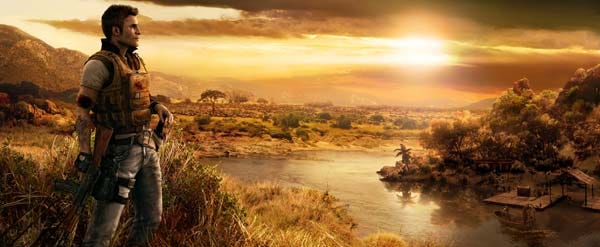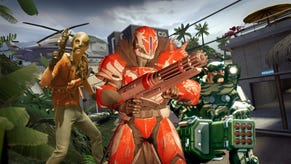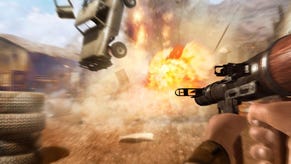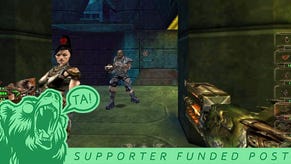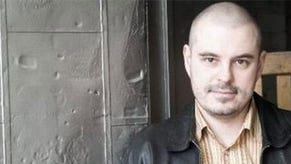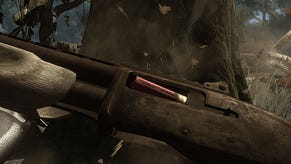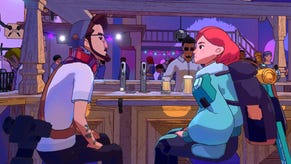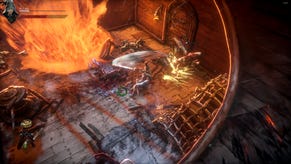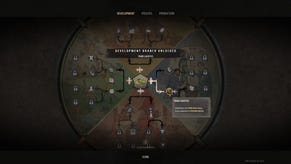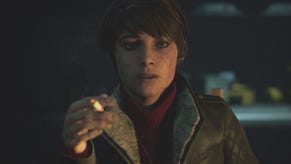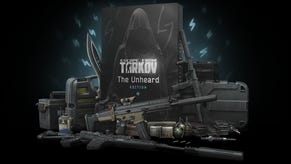Clint Hocking on Far Cry 2
I don't know about you lot, but all that Far Cry 2 coverage left me with a few questions about the game. So I dropped a line to Mr Clint Hocking, a creative director at Ubisoft Montreal, and the lead brain on Far Cry 2. He's a clever sort, and was patient enough to talk about how non-linear storytelling works, how your NPCs buddies operate in the game world, how bits of a car can be your undoing, the potential for exploration in a 50km tract of videogame Africa, the "visceral punch" of the injury system, and how people will overlook the awesomeness of a guided missile system.
Read on for a verbal monsoon of all things Far Cry 2. This is a game worth paying attention to.
RPS: Can you tell us a little about how you've approached telling a story in a non-linear game world? What kind of problems did you encounter with this during development?
Hocking: To tell a meaningful and engaging story in an open, non-linear world, we decided we needed to tell an open, non-linear story – a story that adapts itself to the player’s actions the same way the non-linear gameplay experience adapts to the player actions. In order to do it, we more or less invented the field of narrative design. Patrick Redding – our narrative designer – is tasked specifically with making sure the story adapts to the player’s actions and decisions. That means that major characters, such as the Warlords, Captains, Lieutenants, and the Buddy characters can live or die based on the actions the player takes and the story will dynamically change based on who lives, who dies, and who the players friends are at any given moment. It was an immensely difficult creative, logistical and technical challenge that required among other things hiring the best writers in the industry to ‘fill in the blanks’ of a truly massive script. We hired Susan O’Connor – one of the writers of Bioshock – to help us bring all these characters to life in the nearly infinite number of permutations possible in the script.
RPS: Did you always know the game was going to be this open-ended and sandbox based? Was it wide open from the start?
Hocking: Yes. We always felt that the best ‘answer’ to the promises of freedom made by the original Far Cry… the best thing we could do to earn a ‘2’ after the title was to deliver a truly open experience where player freedom and the players decisions drive the experience. Consequently, from almost the beginning, we were converging toward a massively open, no-loading world and building the game engine that would make it possible. And it’s not just ‘spatially’ open that we were striving for – it was also our intent to give the player the freedom to complete his objectives the way he wanted, using the tools at his disposal, rather than forcing him to do X, Y or Z because it was ‘cooler or sexier’. Sure wiping out an enemy camp with a flamethrower is cool, but forcing the player to do it the way we think is cool makes it tiresome and potentially frustrating. What is REALLY cool is enabling the player to see the challenge in front of him, adapt his strategy to suit it, and then improvise using a solution on the fly as new elements are thrown at him.
RPS: Games as ambitious as this often end up scrapping loads of ideas - is there much that had to go on the Far Cry 2 scrapheap?
Hocking: Not much. Because our vision was so open and systemic and so heavily interconnected, we encountered a few hurdles where we realized there was no real valid path to descope – frequently, descoping meant MORE work than delivering the original promise. A massively systemic game is something like a house of cards – removing all the 7’s from the deck when the house is half built is certain collapse. That said, we did make cuts, but we were always tracking the problem and its potential cascading repercussions. In the end, the cuts we did make were not major, and it was excellent project management and oversight that allowed us to recover from serious cascading failure. In any case, I do not believe it is possible to make a game of this complexity and scope without top-notch project management and confidence in the vision coming from the highest levels.
RPS: Do you expect the linear shooter to fade out in the light of recent wide-open game designs?
Hocking: I am torn on this question. For me, personally, I find it much, much harder to become engrossed in your ‘typical’ linear FPS after having worked on and played Far Cry 2 for so long now. However, at the same time, the level of polish and execution in games like CoD4 is insanely high. My feeling is, tightly controlled and scripted ‘cinematic experiences’ like CoD4 will always remain competitive, but that the number of studios who can deliver this level of polish will diminish rapidly. I think the environment will become even more competitive than it is now.
RPS: The shooting looks great, but to what extent is stealth supported? And what about ingenious use of physics?
Hocking: Well, it’s not Splinter Cell – but stealth, observation and surprise are important elements to successful play. Simply charging in blindly without regard for where the enemies are is insanely fun, but – at the higher difficulties especially – it becomes suicidal. If stealth is your thing, play on a harder difficulty and you’ll really be forced to observe, take out snipers and long range patrollers, scout the location using your map and monocular, and then try to make a big ‘first strike’ that disorients the enemy and takes out several of them in a single hit. As for physics – given the amount of freedom to use the games objects, there are many ingenious ways to use physics, but at the same time, the game is highly simulational and realistic. Shooting a barrel to make it roll and crush an enemy in mostly idiotic compared to shooting the enemy directly. Shooting destructible platforms with rockets in order to make an enemy fall to his death is typically pointless because the rocket explosion has already killed him.
RPS: What kind of friendly NPCs are we expecting to see in the game? Are you going to be fighting alongside allies as in Stalker?
Hocking: There are 12 Buddy characters. Your very first action on starting a new game is to choose one of them as your avatar. The other 11 go on to populate the dynamic story. You can meet any of them in virtually any order and the ones who live will rise in importance in the main story. The ones who die will be… well… dead. You frequently fight alongside them – such as when they come to bail you out after you’ve been downed in battle, or when you work with them to increase the stakes of a mission – but they are not squad-mates, and they do not take orders. They are autonomous, they know who is the enemy, and they will defend themselves and you to the best of their ability while they are on the field. You will need to do the same if you want to keep them alive.
RPS: Tell us a little about some of the injury stuff we've been seeing - was that a stake being pulled out of the player-character's leg on a recent trailer?
Hocking: Yes. To explain it literally, the player has 5 ‘bars’ of health. When a bar is partially drained, it will regenerate, but when a bar is completely drained, it will not. You need to inject yourself with syrettes or sleep in a safe house to restore your health to full. However, when you are in your LAST health bar, you are critically wounded and about to die. You have a limited amount of time to deal with your injury or you will pass out or die. When critically wounded, you need to perform emergency first aid before you can use a syrette. This plays a contextual animation based on the type of injury you received and the location of the injury. If you fell from a cliff, you might have a dislocated ankle that needs to be relocated. If you were shot in the leg, you might need to prise the bullet out with a knife, if you were hit by a grenade blast you might need to pull shrapnel our of your elbow… the idea is to hit the player with a visceral ‘punch’ right at the moment that the intensity is highest and his adrenalin is pumping. The combined effect is to create powerful psychosomatic bonds between the player, the avatar and consequently the world itself.
RPS: So you're quoting fifty hours of game? And no "kill 50 rabbits" missions? Really?
Hocking: Yes really. It could well be longer depending on how much of an explorer you are and how interested you are in unlocking and upgrading all the guns, unlocking the Safe Houses, scouting the Guard Posts, completing side missions etc. We have no missions of the absurd timed/collection sort… we have more than enough game that we didn’t need to ‘pad is out’ with absurd side quests to fill the world.
RPS: To what extent is the game about exploration? Is everything on the map, or will players really feel like they're discovering things that were hidden?
Hocking: Exploration is an important part of the game if you want to do more than just the ‘main’ missions. You can do the game in a very straight forward way, unlocking only a few weapons with the diamonds you get paid for the main missions and you’ll be fine… but if you want to increase your reputation, if you want to work with your buddies, if you want to help the civilians and the underground, if you want to take side missions and unlock more weapons, equipment and all kinds of upgrades, then you’ll want to explore. You get paid in rough ‘conflict’ diamonds for doing the main missions of the game, but you can also find them by exploring in the world. These diamonds are the main currency and they are everywhere, but they are easy to find using the diamond tracker that is in you GPS. Unlocking and upgrading Safe Houses by working with the Buddies is also valuable, and scouting the Guard Posts in the world so you know which supplies can be recovered from where is another very valuable and rewarding thing to do. Some of these things – like the positions of Safe Houses and Guard Posts are marked on the map – but once a guard post is unlocked, its icon is updated with an indicator of what supplies you can get there. Diamonds are marked on the map once you have found them, so completionists don’t have to worry about trying to remember which ones they have found already. So the answer to your question is ‘both’ – there is a lot of exploration for those who want it, but there are different kinds of indications to assist or to emphasize discovery depending on what specifically is being explored.
RPS: Tell us about an incidental detail in your game world that you think will be overlooked by someone reviewing the game.
Hocking: One thing a lot of players have not yet noticed is that the CG Guided Missile system – one of the most advanced and most expensive weapons in the game – has some sophisticated secondary functionality. You can just fire the rocket normally, just like with the RPG, but also you can guide the rocket by aiming through the scope. This makes it incredibly more effective at taking out enemy vehicles at range. Also, pulling the trigger a second time while the rocket is in-flight can air-burst the rocket, instantly detonating it, which is ideal for killing enemies hiding behind hard cover… if the enemies are behind a stone wall or the corner of a building, fire the rocket just past the corner and pull the trigger – the detonation will kill them behind their cover. Also – the missile itself has a very dangerous back-blast – a jet of flame some 3 meters long. This rocket back-blast when you fire the weapon can ignite the grass or bushes behind you. You can use it intentionally to start harassment fires, but it also forces you to displace, meaning you can so easily abuse the power of this weapon.
RPS: So this map editor looks great, if you like that sort of thing. Are you expecting a deluge of single-player scenarios made by players?
Hocking: Whoa… no. I hope there is no misunderstanding here, but the release version of the level editor will not allow players to create single player scenarios. Our world is a single continuous 50km square open world, and there would be no way to even ENTER a user-made map from that world, even if it was possible. Regardless, the main reason the map editor is so powerful is that we don’t saddle players with the complex and hard to debug issue of generating navigation data for AI, nor with the sophisticated scripting tools that allow the generation of mission scenarios. Sorry if there was a misunderstanding about what the level editor is capable of, but it is only for the creation and sharing of multiplayer maps.
RPS: I'd imagine your team are full of anecdotes for things that have happened in the game - do you have a personal favorite experience you'd like to share with our readers?
Hocking: I got killed by the hood of a car once... I was in a gun fight with some guys at a guard post and an enemy took cover behind a vehicle. I sprayed at him and the hood of the car popped open. I realized I missed and went to iron sights to fire a tighter burst at him just as the broken hood flapped up on its hinges and blocked my burst, stopping bullets dead or simply deflecting any that managed to penetrate the thin steel. I released my sights as the hood fell back down and saw my target was still alive. I raised my sights again and put another burst at him as the hood of the car dropped down and bounced back up again from the impulse of my previous burst. Again the rounds bounced off or deflected wildly through the hood of the car… I lowered my sights as the hood of the car dropped back again and saw the bastard was still alive. I raised my sights AGAIN and let go with yet another burst. This time, the hood popped up and took the shots, but the relentless fire from my gun tore the hood off its hinges and sent it flying straight up in the air. Lowering my sights again, I saw the guy was still – unbelievably – alive. With no hood in the way now, I unleashed the last of my clip… just as the hood fell from the sky and crossed my line of fire, blocking the burst – then my gun jammed.
By this time, all my screaming and swearing had attracted a crowd of people from the team who were watching and laughing at my uncanny misfortune. Panicking now, with enemies closing from all directions I switched to my sidearm and charged the guy, finishing him with a tight grouping from my .45. I got in the car and sped away avoiding the rest of the combat. Moments later, clear of the camp and out in the desert, a realized how bad the vehicle was damaged from all the gun fire I put into the engine block. Black smoke everywhere, which indicates the vehicle is close to catching fire and eventually exploding, I climbed out and went to repair the engine. Half-way through the repair job, I heard gunfire. Enemies from the camp I had just fled were pursuing me in a truck with a mounted gun. It was only two guys and I was pissed, so I took cover behind the wreck and took out my rifle… still jammed. As I cleared the jam, the enemies continued to put machine gun rounds into my vehicle… in my panic and hatred of my pursuers, I had forgotten how badly damaged the vehicle was and that there was no hood protecting the engine from the barrage of gun fire… just as it dawned on me how much trouble I was in, the car exploded and killed me… despite all of my discipline and my courage under fire, I was beaten by the hood of a goddamn car. It was humiliating.
Thanks Clint!
Far Cry 2 will be available on October 21st in North America, and October 24th in Europe. Ooh!
